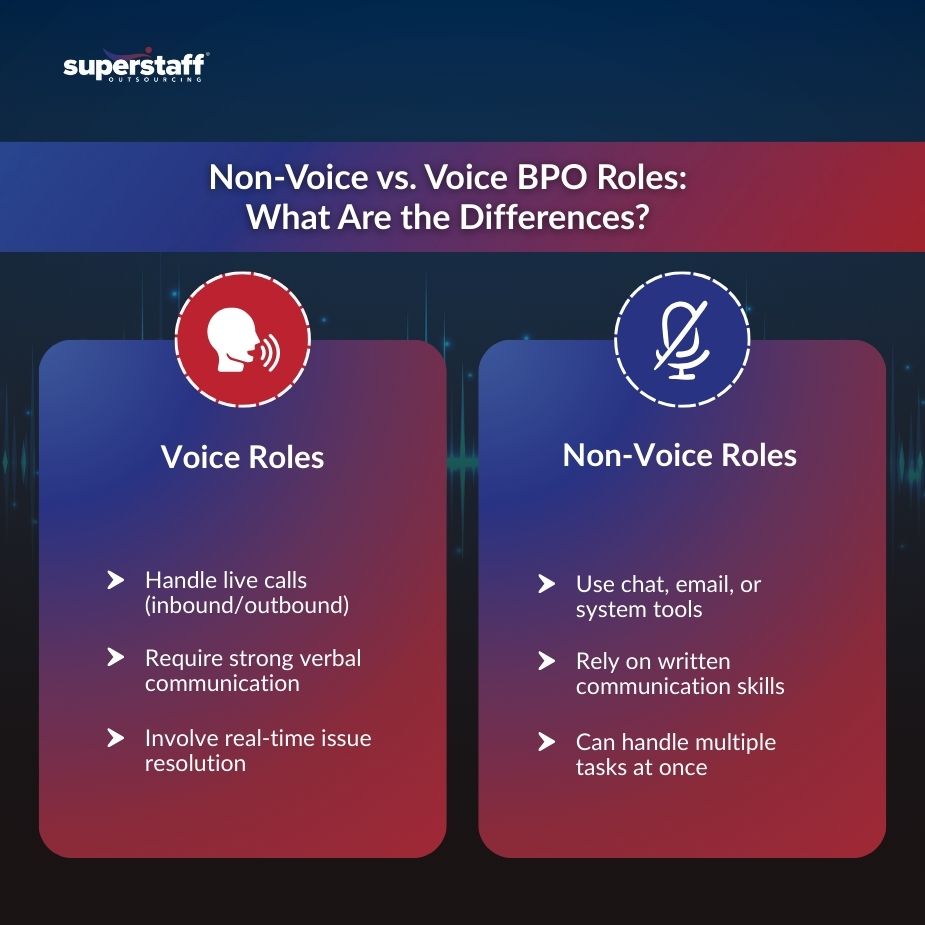
The BPO industry is no longer voice-dominated.
What was once defined by rows of headset-wearing call center agents is now being reshaped by digital transformation. As companies move toward omnichannel customer experiences, the debate of non voice vs voice support has become increasingly relevant. While both offer essential services, their growth trajectories diverge, and decision-makers must pay attention.
In this blog, we’ll explore which BPO roles are in demand in 2025, what’s driving this shift, and how businesses can align their outsourcing strategy with their long-term goals. Whether you’re a startup scaling fast or an enterprise optimizing cost and quality, understanding the new BPO landscape can help you partner with the top customer service outsourcing companies for the right results.
Non-Voice vs. Voice Roles: Serving Different But Complementary Business Needs
In the simplest terms, voice roles involve talking. Non-voice roles do not. But that’s only scratching the surface.
Voice BPO roles focus on real-time communication through inbound and outbound calls. These include customer service hotlines, tech support desks, sales calls, and collections. These jobs rely heavily on agents’ ability to resolve issues quickly, think on their feet, and demonstrate empathy.
Non-voice BPO roles, on the other hand, operate primarily via written or system-based communication. These include email and chat support, social media moderation, order processing, data entry, and analytics. These roles are increasingly becoming more sophisticated as companies demand high accuracy, faster turnaround times, and greater integration with business tools.
As workflows become more integrated, hybrid roles are emerging. A single support agent may begin with a live chat, escalate to a voice call, then send a follow-up email, handling all three without passing the customer to another team.
With those distinctions in mind, let’s look at which side is seeing faster growth.
Non-Voice Roles Are Seeing Faster Growth in Industries Embracing Digital-First Service Models
The BPO industry in the Philippines is evolving. As customer behavior becomes more digital-first, non-voice roles are expanding at an accelerated rate.
Today’s consumers expect instant answers through live chat, social media, and email. They don’t want to wait on hold. In e-commerce, for instance, outsourced teams now handle large volumes of inquiries about orders, returns, and payments entirely through chat. In fact, data from multiple top customer service outsourcing companies shows that live chat volumes are growing 2–3x faster than voice calls.
In healthcare outsourcing, back-office support roles are also booming. Claims processing, patient data entry, billing, and appointment scheduling are all classified as back office jobs, and they’re critical for operational efficiency. Outsourced healthcare teams, often working from HIPAA-compliant environments, handle these non-customer-facing tasks so clinical staff can focus on patient care.
E-commerce and fintech are further accelerating demand for non-voice talent. From fraud detection to content moderation to ticket resolution through email, these roles are essential in ensuring smooth operations, compliance, and customer trust.
Still, while non-voice roles are scaling fast, voice isn’t disappearing.

Voice Roles Are Evolving to Focus on Complex, High-Empathy Interactions
Voice support isn’t going extinct—it’s becoming more specialized.
With AI and automation handling simpler tasks, voice roles now focus on complex, high-emotion scenarios where a human touch matters most. Think of a parent calling to understand their child’s insurance denial. Or a customer needing a refund after a frustrating delivery delay. These are not issues that bots can resolve with a script.
Industries like healthcare, financial services, and travel still rely on voice-based communication to manage sensitive, high-stakes conversations. In fact, some of the top customer service outsourcing companies are investing in training agents for empathy, active listening, and real-time problem-solving skills that machines cannot replicate.
Automation is also changing voice BPO jobs. Agents now work with AI-powered call transcripts, sentiment analysis, and auto-filled forms. While volume may decrease, the complexity of calls is increasing, making these roles even more critical to brand loyalty.
The bigger question isn’t which is better—it’s how businesses are choosing to combine them.
The Fastest-Growing BPO Teams in 2025 Are Blended Teams That Combine Voice and Non-Voice Expertise
In 2025, successful outsourcing isn’t about choosing voice or non-voice—it’s about knowing when to use both.
Companies across industries are adopting blended support teams that can manage phone calls, chat, email, and even social media—all in one workflow. This isn’t just about efficiency; it’s about providing consistent experiences regardless of how the customer reaches out.
Omnichannel support has become the baseline. Today’s consumers often start with a live chat, switch to a phone call, and then expect a follow-up email confirmation. BPOs that train agents across channels are better equipped to meet these expectations without sacrificing speed or quality.
To meet this demand, upskilling and cross-functional training have become top priorities among outsourcing providers. From small businesses to global enterprises, companies are looking for outsourcing partners that offer flexibility, not just headcount.
For brands looking to outsource in 2025, understanding this trend is essential. Role growth isn’t about volume—it’s about capability.
Choosing the Right Mix of Voice and Non-Voice Support Depends on Your Industry and Customer Behavior
There is no one-size-fits-all solution.
The non-voice vs voice decision depends on your industry, customer demographic, and business priorities.
- Retail and e-commerce companies tend to rely heavily on non-voice channels like chat and email for order updates, returns, and FAQs.
- Healthcare and insurance still require voice support for complex issues, compliance explanations, or emotional patient interactions.
- SaaS companies often use a combination: chat for onboarding and bug fixes, voice for escalations and product walkthroughs.
Demographics also play a role. Millennials and Gen Z prefer live chat and self-service, while older customers are more likely to pick up the phone.
Operational goals matter, too. Are you aiming for faster response times? High emotional engagement? Detailed documentation? Your outsourcing strategy must reflect these goals.
This is where top customer service outsourcing companies like SuperStaff come in—with tailored strategies based on your customers, your tech stack, and your growth targets.
SuperStaff Offers Scalable Voice and Non-Voice Solutions Tailored to Business Growth
SuperStaff understands that the future of outsourcing is not about choosing sides—it’s about building the right mix for your business.
We offer scalable voice and non-voice solutions across industries, including retail, healthcare, fintech, and logistics. Our agents are trained to communicate and engage across platforms, including voice, email, live chat, social media, and back-end systems.
Our tech infrastructure supports real-time analytics, productivity dashboards, and transparent reporting, giving you full visibility into team performance and customer outcomes. We also prioritize cultural alignment, ensuring our teams understand your brand, tone, and customer expectations.
Whether you need empathetic voice support or accurate non-voice task execution like back office jobs, we have the capability and agility to build the team you need—fast.
In today’s diverse and demanding CX landscape, flexibility isn’t a luxury. It’s essential.
Choosing Between Non-Voice vs. Voice? It’s Not Either/Or—It’s About the Right Mix
The debate between non-voice vs voice is no longer about which is “better.” It’s about which one works best for your customers, your industry, and your business goals. The most effective approach is a blended model that integrates both, customized to your CX strategy.
Whether you’re building a customer support team from scratch or scaling your existing one, choosing the right partner is key. The top customer service outsourcing companies aren’t just filling roles—they’re helping clients rethink what those roles should be.
Talk to SuperStaff today to discover how we can help you build a right-fit team of voice and non-voice professionals—and grow smarter in 2025.






